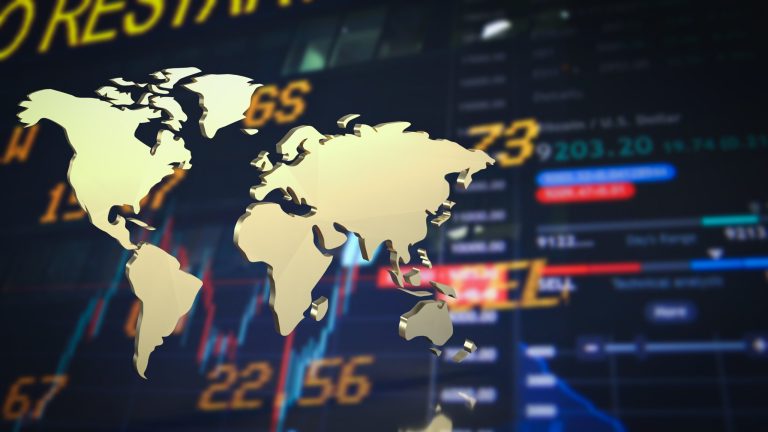The commodity markets in 2024 experienced wild swings from gold prices touching record highs to cocoa emerging as the best performer in the complex.
The year saw growing conflicts in the Middle East region, while the Russia-Ukraine continued to rage on, affecting the oil and grains markets.
Meanwhile, the US Federal Reserve also cut interest rates for the first time in four and a half years in September.
Oil demand remained subdued as China’s economy continued to struggle.
As the markets set to draw curtains on 2024, below are the top trends from the commodity markets this year:
Cocoa outperforms Bitcoin
In 2024, the cocoa futures market experienced dramatic volatility and record price movements.
At the time of writing, the US cocoa prices were more than 170% higher since the start of the year.
This rise has outperformed Bitcoin’s nearly 130% gain this year so far.
Early in the year, cocoa prices began to surge, driven by concerns over tight global supplies due to drought and disease in West African producers.
By March, cocoa futures in New York hit unprecedented levels, exceeding $8,000 per ton, doubling from the previous year.
This surge was attributed to a significant supply deficit, with cocoa production falling short of consumption by about 500,000 tonnes, the largest in over 65 years.
Last week, US cocoa futures surged above $12,000 per ton for the first time.
Analysts with ING Group said in a note:
Recent weather reports suggest that current dry conditions in West Africa are posing threats to cocoa trees and are expected to hamper output in February and March next year.
OPEC+ production cuts
The Organization of the Petroleum Exporting Countries and allies continued to influence the oil market with output cuts throughout 2024.
The cartel was set to increase production in July, unwinding some of the voluntary output cuts of 2.2 million barrels per day.
However, subdued demand for oil from China and falling prices meant OPEC had to extend these cuts multiple times.
At its latest meeting earlier this month, the cartel had agreed to extend the 2.2 million barrels per day voluntary output cut till the end of March 2025.
On top of this, OPEC has been sitting on a 3.65-million-barrels-per-day of cuts since the last one and a half years.
At its meeting earlier this month, OPEC agreed to extend these overall cuts by a year till the end of 2026.
Therefore, OPEC’s total output cuts currently amount to 5.85 million barrels per day, which is nearly 6% of the global oil supply.
As the group maintains such steep production cuts to prop up prices, crude oil has remained rangebound through most of 2024.
Middle East tensions boil over
In October, Iran launched a ballistic missile attack on Israel retaliating against the alleged assassination of Hezbollah and Hamas leaders, which raised concerns about oil supply from the region.
Subsequently, oil prices spiked more than 8% after the attack.
Israel retaliated later in October, targeting military facilities in Iran, escalating tensions between the two sides.
Simultaneously, the conflict in Gaza intensified with Israel’s military operations, leading to airstrikes that caused significant civilian casualties, with reports of attacks on schools and hospitals.
October also marked the first anniversary of the beginning of Israel’s war against Hamas in Gaza.
Russia-Ukraine war
Russia and Ukraine continued their conflict in 2024 with no end in sight.
Throughout the year, Russian forces focused on slow, incremental advances, particularly in the Donbas region, where they captured strategic locations like Avdiivka after months of brutal fighting.
The conflict saw a shift with Ukraine’s limited use of US-provided weapons for strikes inside Russia, particularly around Kharkiv, under new guidelines from the Biden administration.
This tactical change aimed at defending critical regions but also risked escalation.
Russia’s President Vladimir Putin warned that the use of Western weapons by Ukraine had lowered the bar for a nuclear war.
Russia and Ukraine are both key exporters of grains such as wheat and corn.
The conflict disrupted supply chains, leading to a spike in grain prices.
Throughout the year, wheat prices saw both highs and lows due to the war and weather concerns.
There was a notable surge in May due to weather concerns in key producing regions like Russia, which faced drought and frost issues, prompting downward revisions in production estimates.
This led to wheat futures rallying, with prices in some markets reaching above $6.87 per bushel.
El Nino leads to droughts
The El Nino weather pattern in 2024 led to droughts in some regions and excess rainfall in others, disrupting agricultural cycles.
In Latin America, particularly in countries like Brazil and Argentina, El Nino’s association with reduced rainfall during critical growing seasons contributed to lower yields for crops like corn, soybeans, and wheat.
Southeast Asia also experienced below-normal rainfall, affecting rice production in major countries like Indonesia and the Philippines, where water shortages and drought conditions forced farmers to replant or abandon crops.
Trump wins US election
In November, Republican Donald Trump won the 2024 US elections against Vice President Kamala Harris.
Trump’s win led to a surge in the dollar and yields on Treasury bonds. US benchmark equities rallied to record highs in November.
The Trump-led rally in the dollar and riskier assets weighed on several commodities, particularly gold and silver.
A stronger dollar makes commodities priced in the greenback more expensive for overseas buyers.
Gold prices fell from a record high of $2,800 per ounce touched in late October. Silver prices also fell from a high of $35 an ounce.
Trump’s victory also clouded the outlook for future interest rate cuts by the US Fed. The President-elect’s expansionary reforms for the US economy and proposed tax cuts are seen accelerating inflation in the country.
Higher inflation is expected to keep the Fed from cutting interest rates further, which is likely to limit the appeal of gold and silver.
Gold hits a series of record highs
The year 2024 has been one of the best for gold in recent years.
The yellow metal had climbed more than 30% at one point from the start of the year.
Even though prices have fallen in the last month or so after Trump’s victory, gold is still more than 20% higher since the start of the year.
Gold prices first breached $2,500 per ounce earlier this year for the first time.
Safe-haven demand spiked after Middle East tensions escalated, and as a result, the yellow metal breached $2,600 per ounce in September.
In October, prices touched a record high of $2,700 an ounce, followed by another lifetime high of $2,800 per ounce.
Gold has been one of the best-performing commodities this year. Meanwhile, silver prices have outperformed gold this year with a rise of 26% so far this year.
The increasing industrial demand for silver has helped prices to surge.
Though the metal has not hit record highs like gold, analysts believe that silver has more upside potential compared to the yellow metal in the upcoming years.
Fed cuts interest rates by 75 bps in 2024
At the beginning of the year, there was a lot of market chatter surrounding the US Fed’s monetary policy easing.
The Fed has cut interest rates by a total of 100 basis points in 2024 over the course of three meetings.
In September, the US central bank delivered a surprising 50 bps cut. It was also the first time in more than four years that the Fed had cut rates.
In the subsequent meetings in November and December, the Fed cut rates by 25 bps in each of the meetings.
The market at the start of the year was projecting a total rate cut of 150 bps.
Nevertheless, the interest rate cuts supported sentiments in the commodity markets.
Lower interest rates increase liquidity in the economy and the borrowing costs decline.
For 2025, the Fed said it will be cautious with the rate-cutting cycle as inflation in the US remained sticky.
The market expects the central bank to cut rates by 50 bps next year compared with previous estimates of a 100 bps cut.
The slowdown in the rate cuts could weigh on gold and silver in 2025.
Trump’s tariffs loom large
With President-elect Trump set to take office at the White House next year, expectations of a trade war between the US and China loom large.
Trump has proposed a 60% tariff on all Chinese imports.
On top of this, he is also expected to impose a 10%-20% tariff on goods imported from other countries.
Trump has already promised sweeping tariffs to bolster the US economy, protect American industries, promote manufacturing, and reduce reliance on foreign shipments.
A trade war with China could affect the global prices of soybeans and corn. China could also impose tariffs of its own on US agricultural imports.
Additionally, he also intends to impose a 25% tariff on Canada and Mexico.
This will also include oil and petroleum products imported from these countries into the US.
Canada and Mexico are two key oil suppliers to the US.
A 25% tariff could make it difficult for oil refineries in the US to source crude oil and petroleum products, leading to higher domestic fuel prices.
The post What trends dominated the commodity market in 2024? appeared first on Invezz










